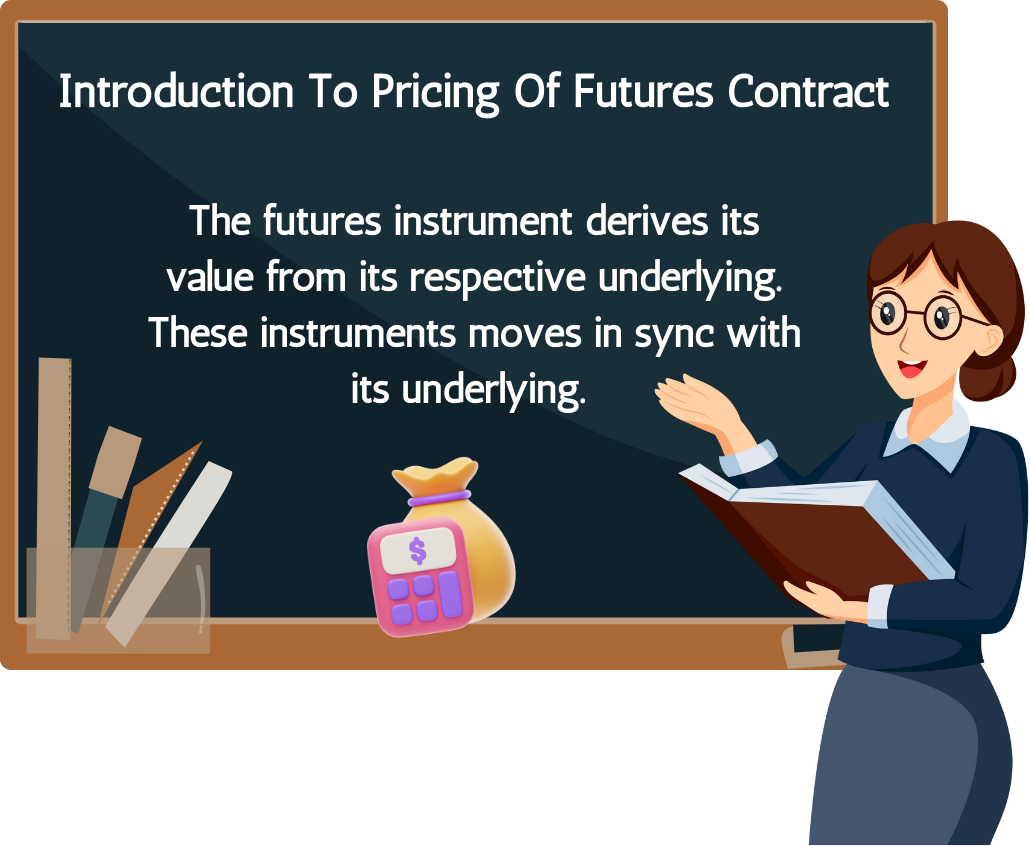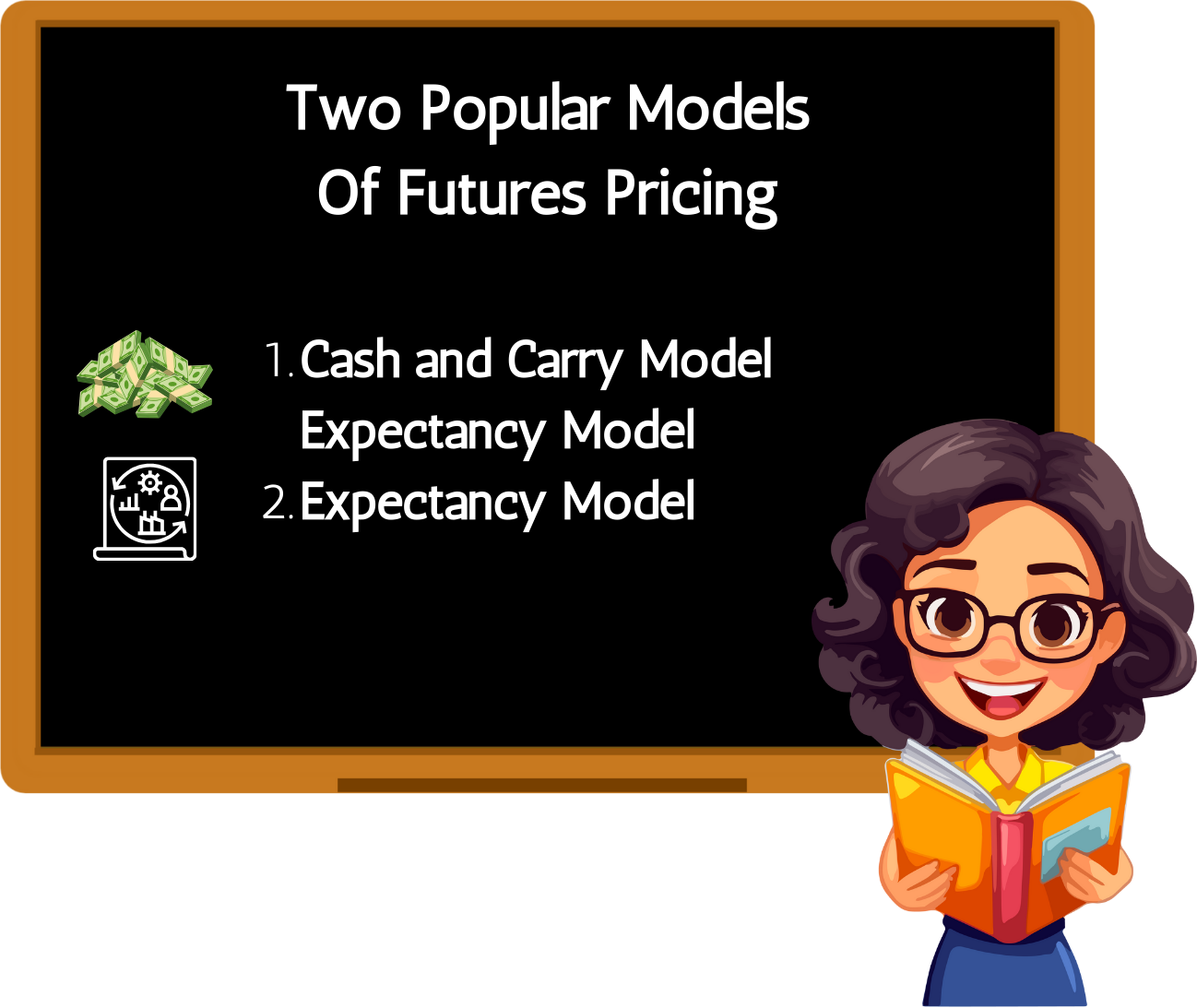- Study
- Slides
- Videos
6.1 Introduction To Pricing Of Futures Contract
The futures instrument derives its value from its respective underlying. These instruments moves in sync with its underlying. If the underlying price falls, so would the futures price and vice versa. However, the underlying price and the futures price differs and they are not really the same. To give you a perspective, Britannia is at 3400 whereas the corresponding current month contract is trading at 3410. This difference in price between the futures price and the spot price is called the “basis or spread”. In case of the Britannia below, the spread is 10 points (3410 – 3400).
6.2 Determining The Prices
A future price is measured by the moves in sync and the cost of the underlying asset. If the cost of underlying increases, the cost of futures will rise and if it decreases, the cost of future will fall.
Remember, the future price is not equal to the value of the underlying asset because, in the market, they can be traded at several different prices.
For example: The spot price of a particular asset can be different than the future price, and the price is called the Spot-future parity.
So what is the possible reason behind the prices that are different at different price frames? Well, it is time to expire, dividends and especially interest rates.
The future price is a mathematical representation of how future price change if any of the variables in the market changes.
Futures Price = Spot price *(1+ rf -d)
Where,
rf – risk-free rate
d – dividend
A risk-free return rate means a return rate on a particular investment with absolutely zero risks-for example – a treasury bill. An individual can adjust a treasury bill proportionately for two to three months until the future expiry. So with that, the formula is:
Futures Price = Spot price * [1+ rf*(x/365) – d]
X – number of days to expiry
Let’s discuss it with an example. To help with calculation, we are assuming the following values.
The spot price of ABC Corporation is Rs 2,380.5
Risk-free rate = 8.35 percent
Days to expiry = 7 days
Futures Price = 2380.5 x [1+8.35 ( 7/365)] – 0
Here we have written zero at the end is because the company is not paying any dividend on it, but if the company pays any dividend, it will be included in the formula.
This futures price formula will give you what we called as the ‘fair value.’ The major difference between market prices and fair value is caused by a margin, taxes, transaction charges, and such.
Using this future pricing formula, one can quickly calculate a fair value for any expiration days.
Mid-Month Calculation: –
Number of days to expiry is 34 days
2380.5 x [1+8.35 ( 34/365)] – 0
Far-Month Calculation: –
Number of days to expiry is 80 days
2380.5 x [1+8.35 ( 80/365)] – 0
The price of a futures contract is just the spot price of an underlying asset that is adjusted for time, interest, and paid out dividends. The difference between the futures price and spot price forms the basis of spread. At the beginning of the series, the spread is maximum, but soon it converges into the settlement date. The future prices and spot price of an underlying asset are equal at the time of the expiration date.
6.3 Two Popular Models Of Futures Pricing
Market participants use different models for pricing futures. The two popular models of futures pricing:
- Cash and Carry Model Expectancy Model
Let us understand this concept with an example. There are 2 people – Bharat & Arjun. Bharat decides to buy a particular stock Dabur in the spot market paying total amount and takes delivery of the share. On the other hand, Arjun decides to buy Dabur in futures paying just the margin. What happens with Bharat’s Position? Dabur shares are credited in his de-mat account. Now if Dabur announces a dividend, Bharat is entitled to that dividend, but simultaneously he loses out on the opportunity cost of the funds involved in buying those Dabur shares in the spot market. He is basically forgoing the interest on those funds.
On the other hand, Arjun deploying just a small margin is holding a similar position in Dabur. When dividend is announced Arjun is not entitled to this dividend as his demat account doesn’t have Dabur shares.
Both Bharat and Arjun are long on Dabur but still their situation has few differences on account of opportunity cost of funds involved as well as dividends received. This is known as cost of carry!
The Cost of Carry Model assumes that markets are perfectly efficient. This means there are no differences in the cash and futures price. No opportunity for arbitrage exists and investors are indifferent to the spot and futures market prices while they trade in the underlying asset.
The model also assumes, that the contract is held till maturity, the price of a futures contract will be equal to the spot price plus the net cost incurred in carrying the asset till the maturity date of the futures contract.
Futures Price = Spot Price + (Carry Cost – Carry Return)
- Here Carry Cost refers to the cost of holding the asset till the futures contract matures. This could include storage cost, in case of commodities, interest paid to acquire and hold the asset, financing costs etc. Carry Return refers to any income derived from the asset while holding it like dividends, bonuses etc. A net of these two is called the net cost of carry. The cost of carry model used for pricing futures is given by:
F= (Se)^rt
Where, S- Spot price
r- cost of financing (using continuously compounded interest rate)
t- Time to expiry
e- 2.71828
- Expectancy Model
According to the expectancy model, it is not the relationship between spot and futures prices but that of expected spot and futures prices, which moves the market. This is why market participants would enter futures contract and price the futures based upon their estimates of the future spot prices of the underlying assets. According to this model, Futures can trade at a premium or discount to the spot price of the underlying asset.
Futures price give market participants an indication of the expected direction of movement of the spot price in the future.
For instance, if the futures price is higher than the spot price of an underlying asset, market participants may expect the spot price to go up in the near future. This expectedly rising market is called “Contango market”. Similarly, if the futures price is lower than the spot price of an asset, market participants may expect the spot price to come down in future. This expectedly falling market is called “Backwardation market” The difference between the spot and the futures price is known as Basis.





